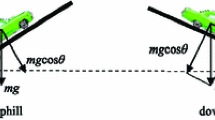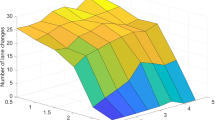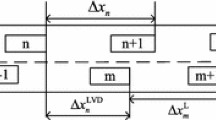Abstract
This paper concerns modeling and computation of traffic flow for a single in-lane flow as well as multilane flow with lane changing. We consider macroscopic partial differential equation models of two types: (i) First Order Models: equilibrium models, scalar models expressing car mass conservation; and (ii) Second Order Models: dynamic models, \(2 \times 2\) hyperbolic systems expressing mass conservation as well as vehicle acceleration rules. A new second order model is proposed in which the acceleration terms take lead from microscopic car-following models, and yield a nonlinear hyperbolic system with viscous and relaxation terms. Lane changing conditions are formulated and mass/momentum inter-lane exchange terms are derived. Numerical results are shown, illustrating the merit of the models in describing a rich array of realistic traffic scenarios including varying road conditions, lane closure, and stop-and-go flow patterns.












Similar content being viewed by others

Notes
The term Fundamental Diagram is often used to denote the flux–density relation, here we use it equivalently to refer to the velocity–density relation.
References
Aw, A., Rascle, M.: Resurrection of “second order” models of traffic flow. SIAM J. Appl. Math. 60(3), 916–938 (2000)
Bando, M., Hasebe, K., Nakayama, A., Shibata, A., Sugiyama, Y.: Dynamical model of traffic congestion and numerical simulation. Phys. Rev. E 51, 1035–1042 (1995)
Benzoni-Gavage, S., Colombo, M.: An n-populations model for traffic flow. Eur. J. Appl. Math. 14, 587–612 (2003)
Berg, P., Mason, A., Woods, A.: Continuum approach to car-following models. Phys. Rev. E 61, 1056–1066 (2000)
Chandler, R.E., Herman, R., Montroll, E.W.: Traffic dynamics: studies in car following. Oper. Res. 6, 165–184 (1958)
Colombo, R.M.: A \(2 \times 2\) hyperbolic traffic flow model. Math. Comput. Modell. 35, 203–223 (2002)
Daganzo, C.F.: Requiem for second-order fluid approximations of traffic flow. Transp. Res. Part B: Methodol. 29, 277–286 (1995)
Del Castillo, J.M., Benítez, F.G.: On the functional form of the speed-density relationship—I: General theory. Transp. Res. Part B: Methodol. 29, 373–389 (1995)
Greenberg, H.: An analysis of traffic flow. Oper. Res. 7, 79–85 (1959)
Greenshields, B.D., Bibbins, J.R., Channing, W.S., Miller, H.H.: A study of traffic capacity. In: Highway Research Board Proceedings (1935)
Helbing, D.: Improved fluid-dynamic model for vehicular traffic. Phys. Rev. E 51, 3164–3169 (1995)
Helbing, D., Greiner, A.: Modeling and simulation of multilane traffic flow. Phys. Rev. E 55, 5498–5508 (1997)
Jiang, R., Wu, Q., Zhu, Z.: Full velocity difference model for a car-following theory. Phys. Rev. E 64, 017101 (2001)
Jiang, R., Wu, Q.-S., Zhu, Z.-J.: A new continuum model for traffic flow and numerical tests. Transp. Res. Part B: Methodol. 36, 405–419 (2002)
Kerner, B.S., Konhäuser, P.: Cluster effect in initially homogeneous traffic flow. Phys. Rev. E 48, R2335 (1993)
Klar, A., Wegener, R.: A hierarchy of models for multilane vehicular traffic I: modeling. SIAM J. Appl. Math. 59, 983–1001 (1998)
Klar, A., Wegener, R.: A hierarchy of models for multilane vehicular traffic II: Numerical investigations. SIAM J. Appl. Math. 59, 1002–1011 (1998)
Leo, C.J., Pretty, R.L.: Numerical simulation of macroscopic continuum traffic models. Transp. Res. Part B: Methodol. 26, 207–220 (1992)
LeVeque, R.J.: Finite Volume Methods for Hyperbolic Problems. Cambridge University Press, Cambridge (2002)
Lighthill, M.J., Whitham, G.B.: On kinematic waves. II. A theory of traffic flow on long crowded roads. Proc. R. Soc. Lond. Ser. A Math. Phys. Sci. 229, 317–345 (1955)
Michalopoulos, P.G., Beskos, D.E., Yamauchi, Y.: Multilane traffic flow dynamics: some macroscopic considerations. Transp. Res. Part B: Methodol. 18, 377–395 (1984)
Payne, Models of freeway traffic and control. In: Mathematical Models of Public Systems, Simulation Council Proceedings Series, vol. 1, no 1, pp. 51–61 (1971)
Richards, P.I.: Shock waves on the highway. Oper. Res. 4, 42–51 (1956)
Roe, P.L.: Upwind Differencing Schemes for Hyperbolic Conservation Laws with Source Terms, pp. 41–51. Springer, Berlin (1987)
Roe, P.L.: Fluctuation and signals—a framework for numerical evolution problems. In: Morton, K.W., Baines, M.J. (eds.) Numerical Methods for Fluid Dynamics, pp. 219–257. Academic Press, New York (1982)
Schochet, S.: The instant-response limit in Whitham’s nonlinear traffic-flow model: uniform well-posedness and global existence. Asymptot. Anal. 1, 263–282 (1988)
Song, J.: Mathematical modeling and simulations of traffic flow, Ph.D. Dissertation, University of Michigan (2019)
Sugiyama, Y., Fukui, M., Kikuchi, M., Hasebe, K., Nakayama, A., Katsuhiro, N., Tadaki, S.-I., Yukawa, S.: Traffic jams without bottlenecks–experimental evidence for the physical mechanism of the formation of a jam. N. J. Phys. 10, 033001 (2008)
Whitham, G.B.: Linear and Nonlinear Waves. Wiley, London (1974)
Wong, G.C.K., Wong, S.C.: A multi-class traffic flow model—an extension of LWR model with heterogeneous drivers. Transp. Res. Part A: Policy Pract. 36, 827–841 (2002)
Zhang, H.M.: A non-equilibrium traffic model devoid of gas-like behavior. Transp. Res. Part B: Methodol. 36, 275–290 (2002)
Acknowledgements
S. Karni has benefitted from stimulating and insightful conversations during a couple of visits to the University of Zurich, Switzerland. The generous hospitality of Rémi Abgrall is gratefully acknowledged. S. Karni wishes to extend her sincere gratitude to Jack Haddad of the Technion, Israel, for stimulating discussions. The authors are also grateful to Romesh Saigal and Philip Roe for productive discussions.
Author information
Authors and Affiliations
Corresponding author
Additional information
In fond memory of Saul Abarbanel, an appreciated teacher, a generous colleague and a warm-hearted mensch.
Publisher's Note
Springer Nature remains neutral with regard to jurisdictional claims in published maps and institutional affiliations.
This work was supported in part by NSF Grant DMS 1417053 and by a University of Michigan Crosby Award.
Rights and permissions
About this article
Cite this article
Song, J., Karni, S. A Second Order Traffic Flow Model with Lane Changing. J Sci Comput 81, 1429–1445 (2019). https://doi.org/10.1007/s10915-019-01023-z
Received:
Revised:
Accepted:
Published:
Issue Date:
DOI: https://doi.org/10.1007/s10915-019-01023-z



